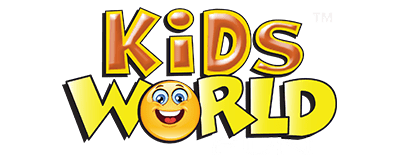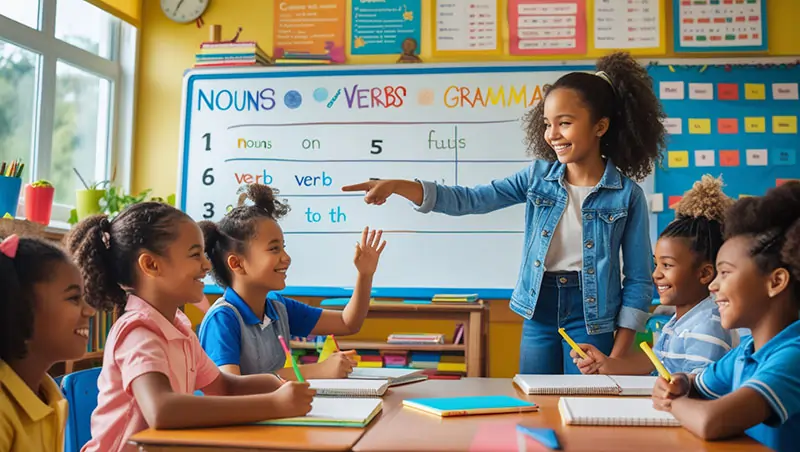Best English Grammar Lessons for Kids
Introduction – Why Grammar Matters for Kids
Every language’s foundation is grammar. Early grammar instruction for children sets the groundwork for good communication—in writing and speaking alike. Children who have poor grammar may find it difficult to clearly express themselves, which would affect their performance in the classroom and confidence in social settings. Children’s view and use of language can be much changed by including fun, interesting, age-appropriate English grammar lessons.
Young children pick up language rules by listening and speaking; structured kids grammar learning helps them to expand on what they already know and expose them to more difficult language patterns. Correct instruction helps grammar not be boring or difficult. Actually, one of the most fun aspects of learning English can be grammar given the correct tools and technique.
Basic Grammar Topics for Kids
Children should be exposed to the basic building blocks of the English language if they are to have a strong basis in grammar. Every child should study these basic subjects:
1. Nouns
People, places, animals, and objects are among the nouns — that name words. Children who can recognize the subjects of sentences will be better able to identify and classify nouns—common, proper, singular, plural.
Example activity: Children could be asked to identify and list every noun in a picture book.
2. Verbs
Verbs are action words. Youngsters should pick up how verbs convey actions and how they vary depending on the tense—run/ran, eat/ate.
Example activity: Play a game where children act out verbs you say (e.g., jump, run, clap).
3. Adjectives
Adjectives explain nouns. They provide sentences with color and complexity.
Example activity: Show a picture and then ask children to name as many adjectives as they can.
4. Sentence Formation
Youngsters should pick up the ability to create basic sentences combining an object, verb, and subject. Developing writing ability requires a grasp of sentence structure.
Tip: Use cards or sentence building blocks with words children can arrange.
5. Tenses
Tenses, past, present, or future, indicate when an action occurs. Early tense introduction helps children accurately recall events.
Fun tip: Discuss what happened yesterday, what’s happening right now, and what tomorrow holds using storytelling.
6. Prepositions
Prepositions (in, on, under, behind) display relationships in time and space. Though challenging, these are absolutely necessary for clarity.
Example game: Use toys to demonstrate prepositions (“Put the teddy under the table”).
Children who master these subjects acquire the skills necessary to build accurate and meaningful sentences—a fundamental component of effective communication.
Fun Ways to Teach Grammar – Games, Songs, and Interactive Tools
Youngsters learn most by playing. Fun grammar activities help to make grammar interesting instead of scary in classes. These interesting techniques help youngsters learn English grammar rules:
1. Grammar Games
- Noun-Verb-Adjective Sorting: Use flashcards to sort words into the correct categories.
- Grammar Bingo: Create bingo cards with grammar terms or sentence parts.
- Sentence Scramble: Give kids jumbled words and challenge them to form proper sentences.
2. Songs and Rhymes
Excellent memory aid are rhymes and songs. Grammar songs on punctuation or parts of speech help kids absorb rules naturally.
For instance, “The Verb Song,” set to a catchy melody, clarifies action words.
3. Role-playing and Storytelling
Using particular grammar rules, e.g., past tense verbs or descriptive adjectives, children can create and act out their own stories.
4. Interactive Grammar Tools
Form sentences on a board using magnetic words, or color-coded tokens for many parts of speech. These tactile instruments help one to make grammar interesting and concrete.
Children stay interested and remember material more successfully when grammar is turned into a game.
Online Lessons and Videos
The internet is a treasure trove of engaging grammar content. Many websites offer English grammar lessons for kids through videos, animations, and interactive exercises.
1. YouTube Channels
- KidsWorldFun: Offers fun and educational videos tailored for children.
- Grammar Songs by Scratch Garden: Colorful videos that use music and animation to explain grammar.
- Kiboomu Kids Music: Great for learning grammar through songs.
2. Websites Offering Free Lessons
- BBC Bitesize: Provides interactive grammar lessons with games and quizzes.
- Education.com: Offers grade-wise grammar activities and printable worksheets.
- K5 Learning: Good for structured grammar programs.
Through multimedia, which is particularly useful for visual and auditory learners, these sites assist in reinforcing grammar ideas.
Printable Grammar Charts and Worksheets
For parents and teachers looking for offline tools, printable resources are incredibly useful for kids grammar learning. Often used repeatedly, charts, posters, and worksheets offer visual support.
1. Grammar Charts
- Parts of Speech Posters: Highlight nouns, verbs, adjectives, etc.
- Sentence Structure Charts: Show how to build simple and compound sentences.
- Tense Charts: Visual guides for past, present, and future tenses.
Tip: Laminate these charts and place them in your child’s study area.
2. Worksheets
- Fill-in-the-blank sentences
- Circle the correct verb tense
- Match adjectives with nouns
Excellent, downloadable worksheets matched with school curricula are available on websites like SuperTeacherWorksheets.com and Twinkl.
Printable materials let kids practice writing and support what they have learned in a practical sense.
Apps for Grammar Practice
Grammar apps in the digital era of today can augment conventional instruction and offer individualized learning. These gamified, interactive, colorful apps grab a child’s attention.
Best Grammar Apps for Kids:
1. Grammaropolis
- Explores parts of speech through animated characters.
- Includes quizzes, videos, and songs.
2. Khan Academy Kids
- A well-rounded educational app with grammar components.
- Features story-based learning and vocabulary games.
3. ABCmouse.com
- Offers a comprehensive English learning program.
- Includes structured grammar lessons with progress tracking.
4. Splat-O-Nym
- Focuses on synonyms and grammar through a game-like interface.
5. Fun English by Studycat
- Teaches grammar with games, songs, and activities designed by language experts.
These apps are ideal for on-the-go learning and can turn screen time into educational time.
Conclusion – Grammar Can Be Fun Too!
Grammar is not a topic that one should dread. Children can enjoy learning grammar just as much as they enjoy playing games or listening to stories if approached correctly. Grammar becomes an adventure rather than a chore when English grammar lessons for kids center creativity, music, and interactivity.
Parents and teachers can create rich surroundings for kids grammar learning by combining online videos, printable resources, mobile apps, and fun grammar activities. Starting with basic English grammar rules for kids, build progressively, and always keep the lessons lighthearted and interesting.
Making grammar enjoyable helps kids develop lifetime communication abilities that will help them in all spheres and all their life.


